
NCERT Solutions For Class 10 Math Chapter – 11 Exercise – 11.1
The NCERT Solutions for Class 10 Maths Chapter – 11 Constructions are undoubtedly an essential study materials for the students studying in CBSE Class 10 NCERT Solutions provided here along with the downnloads PDF can help the students prepare effectively for their first term exams The chapter is a continuation of what was taught in chapter probability in Class 9 and further explains the different concept related to it.
In each of the following, give the justification of the construction also:
- Draw a line segment of length 7.6 cm and divide it in the ratio 5 : 8. Measure the two parts.
Construction Procedure:
A line segment with a measure of 7.6 cm length is divided in the ratio of 5:8 as follows.
- Draw line segment AB with the length measure of 7.6 cm
- Draw a ray AX that makes an acute angle with line segment AB.
- Locate the points i.e.,13 (= 5+8) points, such as A1, A2, A3, A4 …….. A13, on the ray AX such that it becomes AA1 = A1A2 = A2A3 and so on.
- Join the line segment and the ray, BA13.
- Through the point A5, draw a line parallel to BA13 which makes an angle equal to ∠AA13B
- The point A5 which intersects the line AB at point C.
- C is the point divides line segment AB of 7.6 cm in the required ratio of 5:8.
- Now, measure the lengths of the line AC and CB. It comes out to the measure of 2.9 cm and 4.7 cm respectively.
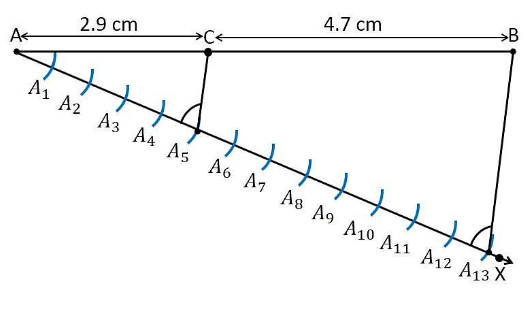
Justification:
The construction of the given problem can be justified by proving that
AC/CB = 5/ 8
By construction, we have A5C || A13B. From Basic proportionality theorem for the triangle AA13B, we get
AC/CB =AA5/A5A13….. (1)
From the figure constructed, it is observed that AA5 and A5A13 contain 5 and 8 equal divisions of line segments respectively.
Therefore, it becomes
AA5/A5A13=5/8… (2)
Compare the equations (1) and (2), we obtain
AC/CB = 5/ 8
Hence, Justified.
- Construct a triangle of sides 4 cm, 5 cm and 6 cm and then a triangle similar to it whose sides are 2/3 of
the corresponding sides of the first triangle.
Construction Procedure:
- Draw a line segment AB which measures 4 cm, i.e., AB = 4 cm.
- Take the point A as centre, and draw an arc of radius 5 cm.
- Similarly, take the point B as its centre, and draw an arc of radius 6 cm.
- The arcs drawn will intersect each other at point C.
- Now, we obtained AC = 5 cm and BC = 6 cm and therefore ΔABC is the required triangle.
- Draw a ray AX which makes an acute angle with the line segment AB on the opposite side of vertex C.
- Locate 3 points such as A1, A2, A3 (as 3 is greater between 2 and 3) on line AX such that it becomes AA1= A1A2 = A2A3.
- Join the point BA3 and draw a line through A2which is parallel to the line BA3 that intersect AB at point B’.
- Through the point B’, draw a line parallel to the line BC that intersect the line AC at C’.
- Therefore, ΔAB’C’ is the required triangle.

Justification:
The construction of the given problem can be justified by proving that
AB’ = (2/3)AB
B’C’ = (2/3)BC
AC’= (2/3)AC
From the construction, we get B’C’ || BC
∴ ∠AB’C’ = ∠ABC (Corresponding angles)
In ΔAB’C’ and ΔABC,
∠ABC = ∠AB’C (Proved above)
∠BAC = ∠B’AC’ (Common)
∴ ΔAB’C’ ∼ ΔABC (From AA similarity criterion)
Therefore, AB’/AB = B’C’/BC= AC’/AC …. (1)
In ΔAAB’ and ΔAAB,
∠A2AB’ =∠A3AB (Common)
From the corresponding angles, we get,
∠AA2B’ =∠AA3B
Therefore, from the AA similarity criterion, we obtain
ΔAA2B’ and AA3B
So, AB’/AB = AA2/AA3
Therefore, AB’/AB = 2/3 ……. (2)
From the equations (1) and (2), we get
AB’/AB=B’C’/BC = AC’/ AC = 2/3
This can be written as
AB’ = (2/3)AB
B’C’ = (2/3)BC
AC’= (2/3)AC
Hence, justified.
- Construct a triangle with sides 5 cm, 6 cm and 7 cm and then another triangle whose sides are 7/5 of the corresponding sides of the first triangle
Construction Procedure:
- Draw a line segment AB =5 cm.
- Take A and B as centre, and draw the arcs of radius 6 cm and 5 cm respectively.
- These arcs will intersect each other at point C and therefore ΔABC is the required triangle with the length of sides as 5 cm, 6 cm, and 7 cm respectively.
- Draw a ray AX which makes an acute angle with the line segment AB on the opposite side of vertex C.
- Locate the 7 points such as A1, A2, A3, A4, A5, A6, A7(as 7 is greater between 5 and 7), on line AX such that it becomes AA1= A1A2 = A2A3 = A3A4 = A4A5 = A5A6 = A6A7
- Join the points BA5and draw a line from A7to BA5 which is parallel to the line BA5 where it intersects the extended line segment AB at point B’.
- Now, draw a line from B’ the extended line segment AC at C’ which is parallel to the line BC and it intersects to make a triangle.
- Therefore, ΔAB’C’ is the required triangle.
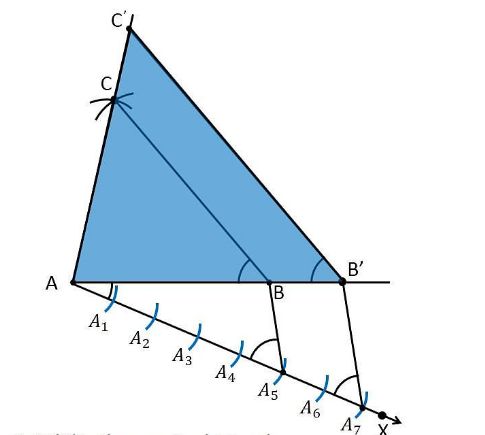
Justification:
The construction of the given problem can be justified by proving that
AB’ = (7/5)AB
B’C’ = (7/5)BC
AC’= (7/5)AC
From the construction, we get B’C’ || BC
∴ ∠AB’C’ = ∠ABC (Corresponding angles)
In ΔAB’C’ and ΔABC,
∠ABC = ∠AB’C (Proved above)
∠BAC = ∠B’AC’ (Common)
∴ ΔAB’C’ ∼ ΔABC (From AA similarity criterion)
Therefore, AB’/AB = B’C’/BC= AC’/AC …. (1)
In ΔAA7B’ and ΔAA5B,
∠A7AB’=∠A5AB (Common)
From the corresponding angles, we get,
∠A A7B’=∠A A5B
Therefore, from the AA similarity criterion, we obtain
ΔA A2B’ and A A3B
So, AB’/AB = AA5/AA7
Therefore, AB /AB’ = 5/7 ……. (2)
From the equations (1) and (2), we get
AB’/AB = B’C’/BC = AC’/ AC = 7/5
This can be written as
AB’ = (7/5)AB
B’C’ = (7/5)BC
AC’= (7/5)AC
Hence, justified.
Construction Procedure:
- Draw a line segment BC with the measure of 8 cm.
- Now draw the perpendicular bisector of the line segment BC and intersect at the point D
- Take the point D as centre and draw an arc with the radius of 4 cm which intersect the perpendicular bisector at the point A
- Now join the lines AB and AC and the triangle is the required triangle.
- Draw a ray BX which makes an acute angle with the line BC on the side opposite to the vertex A.
- Locate the 3 points B1, B2and B3on the ray BX such that BB1 = B1B2 = B2B3
- Join the points B2C and draw a line from B3which is parallel to the line B2C where it intersects the extended line segment BC at point C’.
- Now, draw a line from C’ the extended line segment AC at A’ which is parallel to the line AC and it intersects to make a triangle.
- Therefore, ΔA’BC’ is the required triangle.

Justification:
The construction of the given problem can be justified by proving that
A’B = (3/2)AB
BC’ = (3/2)BC
A’C’= (3/2)AC
From the construction, we get A’C’ || AC
∴ ∠ A’C’B = ∠ACB (Corresponding angles)
In ΔA’BC’ and ΔABC,
∠B = ∠B (common)
∠A’BC’ = ∠ACB
∴ ΔA’BC’ ∼ ΔABC (From AA similarity criterion)
Therefore, A’B/AB = BC’/BC= A’C’/AC
Since the corresponding sides of the similar triangle are in the same ratio, it becomes
A’B/AB = BC’/BC= A’C’/AC = 3/2
Hence, justified.
- Draw a triangle ABC with side BC = 6 cm, AB = 5 cm and ∠ABC = 60°. Then construct a triangle whose sides are 3/4 of the corresponding sides of the triangle ABC.
Construction Procedure:
- Draw a ΔABC with base side BC = 6 cm, and AB = 5 cm and ∠ABC = 60°.
- Draw a ray BX which makes an acute angle with BC on the opposite side of vertex A.
- Locate 4 points (as 4 is greater in 3 and 4), such as B1, B2, B3, B4, on line segment BX.
- Join the points B4C and also draw a line through B3, parallel to B4C intersecting the line segment BC at C’.
- Draw a line through C’ parallel to the line AC which intersects the line AB at A’.
- Therefore, ΔA’BC’ is the required triangle.
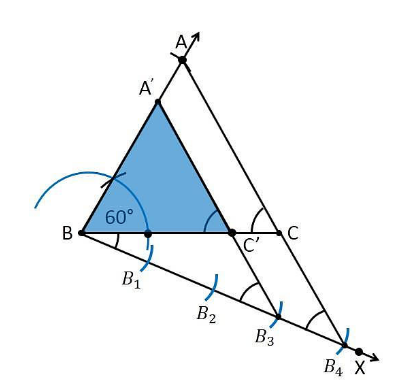
Justification:
The construction of the given problem can be justified by proving that
Since the scale factor is 3/4 , we need to prove
A’B = (3/4)AB
BC’ = (3/4)BC
A’C’= (3/4)AC
From the construction, we get A’C’ || AC
In ΔA’BC’ and ΔABC,
∴ ∠ A’C’B = ∠ACB (Corresponding angles)
∠B = ∠B (common)
∴ ΔA’BC’ ∼ ΔABC (From AA similarity criterion)
Since the corresponding sides of the similar triangle are in the same ratio, it becomes
Therefore, A’B/AB = BC’/BC= A’C’/AC
So, it becomes A’B/AB = BC’/BC= A’C’/AC = 3/4
Hence, justified.
- Draw a triangle ABC with side BC = 7 cm, ∠ B = 45°, ∠ A = 105°. Then, construct a triangle whose sides are 4/3 times the corresponding sides of ∆ ABC.
To find ∠C:
Given:
∠B = 45°, ∠A = 105°
We know that,
Sum of all interior angles in a triangle is 180°.
∠A+∠B +∠C = 180°
105°+45°+∠C = 180°
∠C = 180° − 150°
∠C = 30°
So, from the property of triangle, we get ∠C = 30°
Construction Procedure:
The required triangle can be drawn as follows.
- Draw a ΔABC with side measures of base BC = 7 cm, ∠B = 45°, and ∠C = 30°.
- Draw a ray BX makes an acute angle with BC on the opposite side of vertex A.
- Locate 4 points (as 4 is greater in 4 and 3), such as B1, B2, B3, B4, on the ray BX.
- Join the points B3C.
- Draw a line through B4 parallel to B3C which intersects the extended line BC at C’.
- Through C’, draw a line parallel to the line AC that intersects the extended line segment at C’.
- Therefore, ΔA’BC’ is the required triangle.
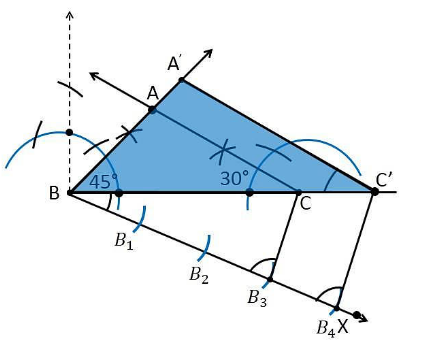
Justification:
The construction of the given problem can be justified by proving that
Since the scale factor is 4/3, we need to prove
A’B = (4/3)AB
BC’ = (4/3)BC
A’C’= (4/3)AC
From the construction, we get A’C’ || AC
In ΔA’BC’ and ΔABC,
∴ ∠A’C’B = ∠ACB (Corresponding angles)
∠B = ∠B (common)
∴ ΔA’BC’ ∼ ΔABC (From AA similarity criterion)
Since the corresponding sides of the similar triangle are in the same ratio, it becomes
Therefore, A’B/AB = BC’/BC= A’C’/AC
So, it becomes A’B/AB = BC’/BC= A’C’/AC = 4/3
Hence, justified.
- Draw a right triangle in which the sides (other than hypotenuse) are of lengths 4 cm and 3 cm. Then construct another triangle whose sides are 5/3 times the corresponding sides of the given triangle.
Given:
The sides other than hypotenuse are of lengths 4cm and 3cm. It defines that the sides are perpendicular to each other
Construction Procedure:
The required triangle can be drawn as follows.
- Draw a line segment BC =3 cm.
- Now measure and draw ∠= 90°
- Take B as centre and draw an arc with the radius of 4 cm and intersects the ray at the point B.
- Now, join the lines AC and the triangle ABC is the required triangle.
- Draw a ray BX makes an acute angle with BC on the opposite side of vertex A.
- Locate 5 such as B1, B2, B3, B4, on the ray BX such that such that BB1= B1B2= B2B3= B3B4 = B4B5
- Join the points B3C.
- Draw a line through B5 parallel to B3C which intersects the extended line BC at C’.
- Through C’, draw a line parallel to the line AC that intersects the extended line AB at A’.
- Therefore, ΔA’BC’ is the required triangle.
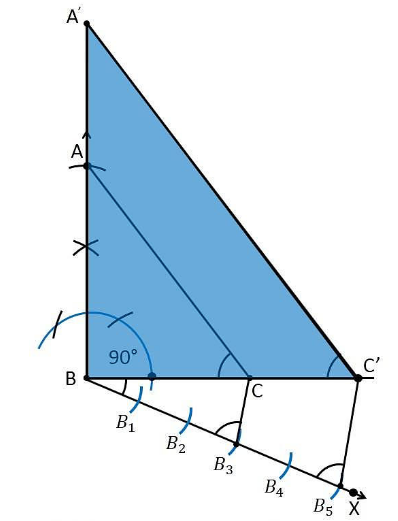
Justification:
The construction of the given problem can be justified by proving that
Since the scale factor is 5/3, we need to prove
A’B = (5/3)AB
BC’ = (5/3)BC
A’C’= (5/3)AC
From the construction, we get A’C’ || AC
In ΔA’BC’ and ΔABC,
∴ ∠ A’C’B = ∠ACB (Corresponding angles)
∠B = ∠B (common)
∴ ΔA’BC’ ∼ ΔABC (From AA similarity criterion)
Since the corresponding sides of the similar triangle are in the same ratio, it becomes
Therefore, A’B/AB = BC’/BC= A’C’/AC
So, it becomes A’B/AB = BC’/BC= A’C’/AC = 5/3
Hence, justified.